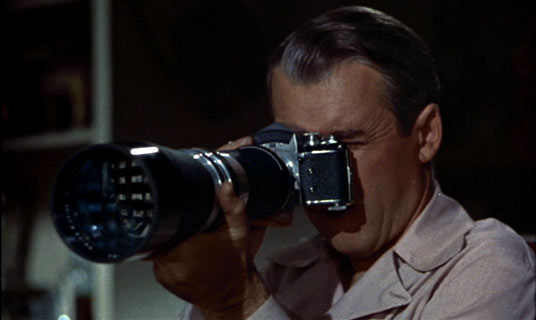
Rear Window by Alfred Hitchcock is an interesting detective film made in the 1950s. James Stewart plays the roll of J.B. Jefferys, a famous photographer that is recovering from a broken leg. With the broken leg Jefferys is unable to leave his apartment so he spends his time looking out the rear window of his apartment at his neighbors. The last week before he gets the cast off of his broken leg he believes he has stumbled apon a murder. He, his lady friend, and his nurse try to uncover the mystery and they try to convince Jefferys' detective friend at they are right.
The lighting in the movie was an important factor. It was generally low-key to show the contrasts of light and dark. The whole setting of the neighbors buildings were lit up including what I found a little strange, the alleyways. It was evenly lit and there didnt appear to be any destinctive shadows. This took away from the realness of the film but it allowed the viewer and Jefferys to see everything clearly.
Being a detective film, Alfred Hitchcock only allowed the viewer to see and hear what Jefferys did, including te music. There was a studio apartment nearby that a composer lived in and if there was music in the film it was being played by him. It was pretty neat that they did this they could include music (music by Franz Waxman) without taking away from the detective part of the movie. Part of the music that this composer played was a motif for Jefferys and his lady friend (played by Grace Kelly). They heard the music several times and stated that it was like he was playing it for them. The dialog throughout the movie was very realistic and the actors did a very good job of their characters. It was as if they were the characters, not just playing them.
Alfred Hitchcock also did a great job with various different shots and angles, making the viewer feel like they knew fit in exactly with the Jefferys and his thoughts. The openning scene has a close up of Jefferys that introduces you to the character and then a little later it shows a view of the neighbors from a high angle to symbolize that Jefferys was wathing over them. Long shots were used as the shots of the neighbors because it let you see all of what was happening as well that it was what Jefferys saw himself. With that Hitchcock also used the eyeling match very well. The viewer could see what Jefferys was looking at and what his expression was too it by going back and forth between Jefferys and what he was looking at. Another technique that Hitchcock used was when Jefferys looked through binoculars or his camera lense. When Jefferys did this, the viewer would see his view, a circular view with the corners cut off like the viewer was looking through the binoculars or camera lense himself. This effect made the film seem even more realistic.
Overall the movie was great and is a wonderful movie to watch. It has a good dose of suspense in it that will keeps it intriguing and makes the viewer want to watch more of it. So if you like detective films or just films in general, this is one that you must see.
1 comment:
Dan-
It sounds like you become part of the movie with how you described it. Thats cool about the music thing, most movies wouldn't be that clever. Good job. Wahoo
Post a Comment